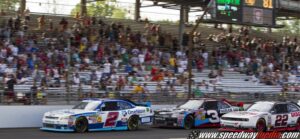[media-credit name=”Dan Sanger” align=”alignright” width=”300″] [/media-credit]The NASCAR Nationwide Series race at the Brickyard is something to talk about – for all the wrong reasons.
[/media-credit]The NASCAR Nationwide Series race at the Brickyard is something to talk about – for all the wrong reasons.
The NASCAR “Super” weekend at Indy will lead to a “Super” discussion after two controversial calls were made by the sanctioning body during the inaugural Indiana 250 at the Indianapolis Motor Speedway.
To describe Saturday’s controversy in simple terms: two different calls were made in what seemed to be the same – or fairly close – scenarios.
With the original start of the race producing a lead change before the cars even made their way to the start/finish line, where Kyle Busch passed pole sitter Kasey Kahne before reaching the line, no penalty was given.
NASCAR’s explanation was that Kahne did not advance in time, allowing Kyle Busch to take advantage within the confines of the rules.
In a late race restart, a very similar incident occurred.
This time, with Brad Keselowski leading and Elliott Sadler in second place, it was Sadler who passed the leader before the line after Keselowski spun his tires.
This time, NASCAR handed down a black flag, taking away a potential victory for Sadler, the Nationwide Series points leader going into the event.
Under these scenarios and NASCAR’s original explanation made during the race after the first issue, what was the difference?
Keselowski seemed to spin his tires and did not advance, just as Kahne did not advance earlier in the event.
Why did the calls not match and which call is right and which is wrong?
Unfortunately, as frustrating as it is, this is not something that can be simply understood.
NASCAR perhaps may have made the right call Saturday due to all the possible scenarios that exist in restart rules. While this may be hard to believe, one thing can be agreed upon – these restart rules can be confusing.
This leads to a very interesting question: is it time to make the restart rules simpler?
Perhaps the days have come where it doesn’t matter who gets to the line first, who changes lanes or who spins tires.
Perhaps when the flag drops, it is just time to go.
Forget the rest. When the green flag drops, everyone can go.
This idea itself may be controversial, but it sure would end a lot of confusion – for fans, drivers and even NASCAR officials.

Leave a Reply